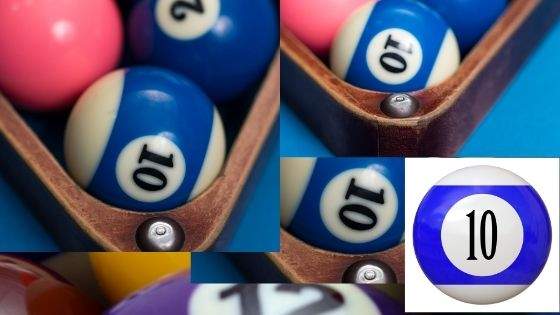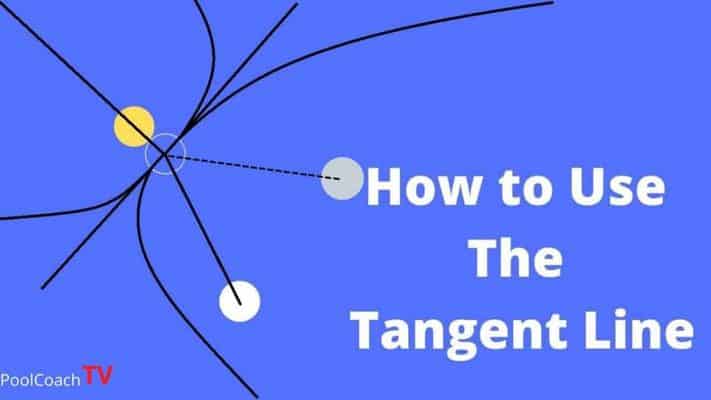Players break and must make the balls in numerical order. Contact is required with the lowest numbered ball first on all shots. Legally making the 10 ball in numerical rotation or during any legal shot wins the game.
In some strict games the 10 ball has to be the last ball on the table. It can be made at other times but does not win the game.
It re-spots and the player continues.
Introduction to Ten Ball.
[Image of a ten ball rack.]
Ten ball is a rotation game of pool similar to nine-ball but with one extra ball, a tougher break and the rule that all balls must be made in a nominated pocket.
Shots should be called unless they are obvious to both players.
The ten balls pocket always needs to be called unless obvious.
Combinations banks and caroms need to be called and slop shots do not count.
Accidental safeties also do not count, it is the incoming player’s option to shoot or pass the shot back to their opponent.
Variations of these strict rules are starting to emerge, so it is always best practice to be acquainted with the local rules in force before starting to play.
These variations include:
The Break.
- Does the 10 ball count on the snap or not?
- If it does, does the ten ball count in all pockets or just the bottom four?
- In the rack, do the 2 ball and 3 ball need to be racked in the corner positions?
- Is the soft break allowed, if not do three balls need to cross the head string?
Note – illegal break shots give the table and the shot choice to the incoming player either to shoot or not.
An illegal break does not result in “ball in hand.”
How To Rack The Balls For A Game Of 10 Ball.
The ten pool balls numbered 1 to 10, are placed inside a rack. Ten ball uses only one more ball than is used in diamond shaped 9 ball rack, but before the break the balls are racked in a triangular formation.
Place the 1 ball at the head of the triangle, this ball will go on the spot.
The ten ball is placed in the middle of the third row of balls.
Usually the 2 ball and 3 ball are placed in the bottom corners of the rack.
All balls should be touching and the 1 ball must be struck first.
Safety Play.
- Do lucky hooks and snookers count or not?
- If you miss a ball and snooker your opponent what happens?
- If accidental safeties do not count, it is the incoming player’s option to shoot or pass the shot back to their opponent.
Jump Shots.
- Do the rules allow for the use of jump shots?
- Can you use a jump cue or are you restricted to using your playing cue?
All Ball Fouls.
All ball fouls means that it is a foul if any other ball is touched by the incoming player.
- This means whenever a player is at the table prior to, during or after the shot.
- This means with any part of the cue, body, clothing or hair etc.
- Balls are not replaced to prior positions.
- Ball in hand foul.
Next Ball in Rotation Fouls.
- Only illegal contact with the next numbered ball in rotation counts as a foul.
- Eg. If a player touches the 4 ball whilst shooting at the 3 ball, it is a foul. (The 4 ball is the next Ball in rotation.)
- If a player touches the 5 ball whilst shooting at the 2 ball, it is not a foul. The incoming player may replace the ball or not.
Whose Turn To Break?
- Winner breaks – whoever wins the previous game breaks the next game.
- Alternate break – Players break in turn regardless of the previous games’ outcome.
- The first break would be decided by coin flip or lagging.
What are the Ten Ball Foul Shots?
Not withstanding the game variations detailed above these are the standard foul shots that apply to the game of ten ball.
- Not making contact with the lowest numbered ball.
- Not making contact with a rail following ball contact.
- Making an illegal contact with cue ball or object ball.
- The white ball entering any pocket.
- Any ball leaving the table playing area.
- Double hits or push shots.
The above fouls shots / scratches result in ball in hand for the incoming player.
Is it Just 9 Ball With An Extra Ball?
The short answer to that question is yes, but there is a whole lot more to ten ball than the addition an blue striped ball. In my opinion, it is a completely different game to nine ball. There are some strong similarities in the skills required to play rotation games which place a premium on great shot making and precise pattern play.
Safety shots are a case in point. In nine ball players often take a “Hail Mary” shot at snookered balls with the knowledge that sometimes good things can happen. If they can get a few balls flying around the table one of them might go into a pocket which would count as a legal shot.
In ten ball however lucky shots don’t usually count, to count you would have to nominate the ball and the pocket to make a legal shot. This does lead to a more deliberate plan for players when playing kick shots. Players often try to send the two balls in specific directions to maintain an advantage or return the safety.
The Ten Ball Break.
With the one ball on the spot and the balls set in a triangular formation, the balls tend to be made less frequently. It is still possible to stop the cue ball in the center of the table but judging the final location of more than a couple of balls becomes very difficult.
The break and run is way harder at ten ball, and as a result of this player stringing racks together is much rarer even at top levels.
Players tend to break 12-15 inches or so either to the left or right of center looking for a full ball contact on the one ball. The power of the break is more controlled than in 9 ball. The hit is a type of stop shot with a pop.
The cue ball transfers most of its power to the rack and pops back towards the center. Players usually try to make the one ball bounce off the side rail towards the bottom corner. This will hopefully leave a simple opening shot on the one ball.
Sometimes the one will go into the middle pocket but this is not desirable.
When using a magic rack the action and final location of the balls can be predicted more easily. This is especially true after a suitable amount of time practicing. The top professionals are really good at dialing in the 10 ball break shot.
The actual 10 ball game flow.
One player breaks the balls from behind the head string. If they make a ball then they carry on shooting if however, they do not make a ball it’s the opponent’s turn to shoot.
Both the incoming player and the player breaking must make contact with the lowest numbered ball usually the one ball. If the one ball was made on the break, then it will be the next lowest ball in rotation and so on.
Whoever is shooting after the break continues to make the balls in numerical order until they are all gone or the player misses. If a player misses the ball at any time the opponent takes over shooting. This continues until all of the balls have been made into a pocket.
The only ball which wins the game is the 10 ball.
Playing ten ball can be quite challenging from a shape / position point of view. Often times the next number Bowl is in an awkward place or at the other end of the table. Players need a high level of skill and Ingenuity to make it from the 1 ball all the way to the 10 ball without missing.
If a player decides that the shot is too difficult or risky for him to take, he can elect to play a safety shot. This is when he will try to hide the lowest number ball from his opponent by leaving other balls blocking direct path to the lowest number ball. This type of safety is called a snooker or a hook.
Ten Ball Match Play.
Player usually agree on a fixed number of games to play in order to decide a winner. In smaller tournaments the it will be a race to 7 or 9. Money matches anywhere from race to 20 all the way up to race to 100 in some recent professional challenge matches.
So why do they play so many games. Quite simply, most of the luck has been removed from the game, so in a longer match the best player usually wins.
This is in sharp contrast to a nine ball match which can be won on luck alone.
Running several back to back racks is not seen so often in ten ball.



